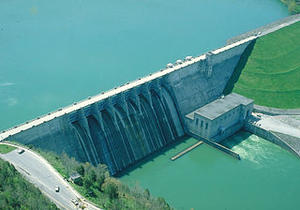InfrastructureWater reservoirs for hydroelectric dams are sources of greenhouse gas emissions
The large reservoirs of water behind the world’s 50,000 large dams are a known source of methane. Like carbon dioxide, methane is one of the greenhouse gases which trap heat near Earth’s surface and contribute to global warming. Methane, however, has a warming effect twenty-five times more powerful than carbon dioxide. The methane comes from organic matter in the sediments that accumulate behind dams.

Hydroelctric generating dams may be a greater contributor to greenhouse gases // Source: commons.wikimedia.org
With the “green” reputation of large hydroelectric dams already in question, scientists are reporting that millions of smaller dams on rivers around the world make an important contribution to the greenhouse gases linked to global climate change. Their study, showing that more methane than previously believed bubbles out of the water behind small dams, appears in the American Chemical Society’s (ACS)’ journal Environmental Science & Technology.
An ACS release reportsthat Andreas Maeck and colleagues point out that the large reservoirs of water behind the world’s 50,000 large dams are a known source of methane. Like carbon dioxide, methane is one of the greenhouse gases, which trap heat near Earth’s surface and contribute to global warming.
Methane, however, has a warming effect twenty-five times more powerful than carbon dioxide. The methane comes from organic matter in the sediments that accumulate behind dams.
That knowledge led to questions about hydroelectric power’s image as a green and nonpolluting energy source. Maeck’s team decided to take a look at methane releases from the water impoundments behind smaller dams that store water less than fifty feet deep.
They describe analysis of methane release from water impounded behind six small dams on a European river. “Our results suggest that sedimentation-driven methane emissions from dammed river hot spot sites can potentially increase global freshwater emissions by up to 7 percent,” said the report. It noted that such emissions are likely to increase due to a boom in dam construction fostered by the quest for new energy sources and water shortages.
The research was funded by the German Research Foundation.
— Read more in Andreas Maeck, “Sediment Trapping by Dams Creates Methane Emission Hot Spots,” Environmental Science and Technology, Articles ASAP (25 June 2013) (DOI: 10.1021/es4003907)
